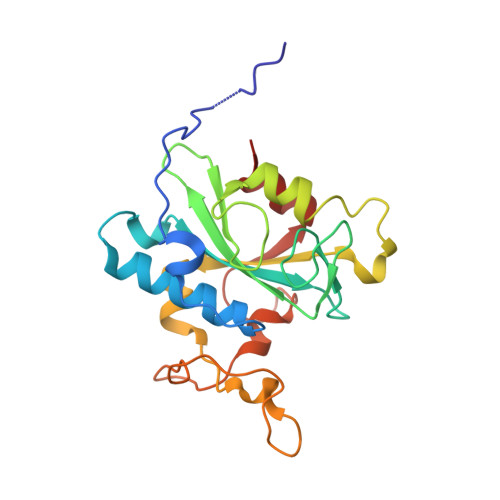Structural study for substrate recognition of human N-terminal glutamine amidohydrolase 1 in the arginine N-degron pathway.
Kang, J.M., Park, J.S., Lee, J.S., Jang, J.Y., Han, B.W.(2024) Protein Sci 33: e5067-e5067
- PubMed: 38864716
- DOI: https://doi.org/10.1002/pro.5067
- Primary Citation of Related Structures:
8JJF, 8JJG, 8JJH, 8JJI, 8JJU, 8JJW, 8JJX, 8JJY, 8JJZ, 8JK0, 8JK1, 8JK2 - PubMed Abstract:
The N-degron pathway determines the half-life of proteins by selectively destabilizing the proteins bearing N-degrons. N-terminal glutamine amidohydrolase 1 (NTAQ1) plays an essential role in the arginine N-degron (Arg/N-degron) pathway as an initializing enzyme via the deamidation of the N-terminal (Nt) glutamine (Gln). However, the Nt-serine-bound conformation of hNTAQ1 according to the previously identified crystal structure suggests the possibility of other factors influencing the recognition of Nt residues by hNTAQ1. Hence, in the current study, we aimed to further elucidate the substrate recognition of hNTAQ1; specifically, we explored 12 different substrate-binding conformations of hNTAQ1 depending on the subsequent residue of Nt-Gln. Results revealed that hNTAQ1 primarily interacts with the protein Nt backbone, instead of the side chain, for substrate recognition. Here, we report that the Nt backbone of proteins appears to be a key component of hNTAQ1 function and is the main determinant of substrate recognition. Moreover, not all second residues from Nt-Gln, but rather distinctive and charged residues, appeared to aid in detecting substrate recognition. These new findings define the substrate-recognition process of hNTAQ1 and emphasize the importance of the subsequent Gln residue in the Nt-Gln degradation system. Our extensive structural and biochemical analyses provide insights into the substrate specificity of the N-degron pathway and shed light on the mechanism underlying hNTAQ1 substrate recognition. An improved understanding of the protein degradation machinery could aid in developing therapies to promote overall health through enhanced protein regulation, such as targeted protein therapies.
Organizational Affiliation:
Research Institute of Pharmaceutical Sciences & Natural Products Research Institute, College of Pharmacy, Seoul National University, Seoul, Republic of Korea.














